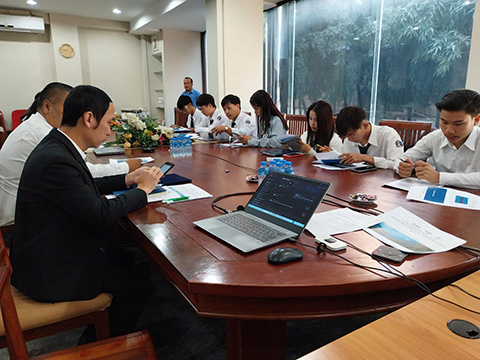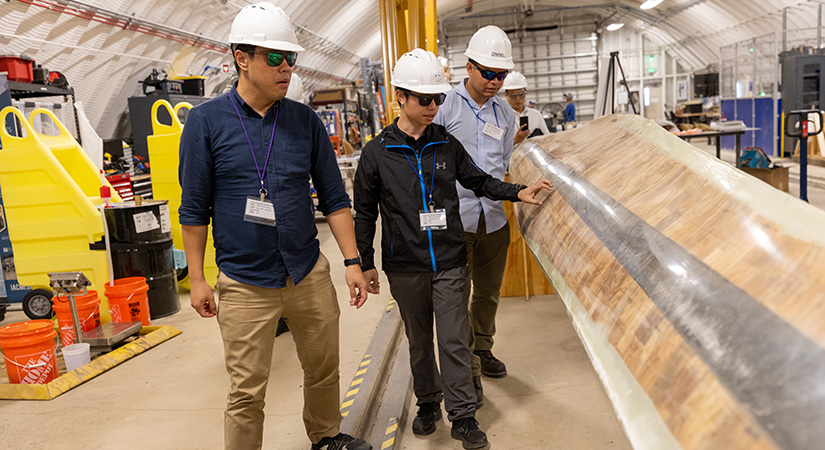Lao Delegates Get Firsthand Look at State-of-the-Art Electric Vehicle Technologies—and So Much More
A Weeklong Visit to NREL’s Colorado Campuses Yields Rewarding Results for Long-Standing USAID Partnership
This past June, under sunny Colorado skies, a group of 10 delegates from the Lao People's Democratic Republic (PDR) could be seen hustling about two of the National Renewable Energy Laboratory's (NREL's) campuses—from conference room to hydrogen fuel cell to research lab—over the course of seven days.
The delegates, who collectively represent Lao PDR's ministries of energy and mines, electricity, and transport, were eager to learn more about research at NREL that could be beneficial for helping their country meet its sustainable transportation and national energy system targets.
The visit came in the middle of a multiyear project, during which NREL has been providing technical assistance, capacity-building trainings, and policy and modeling expertise to key government stakeholders, with support from the U.S. Agency for International Development (USAID) Mission in Laos.
Through its partnership with USAID, NREL has worked with 55 countries to facilitate energy- and transport-sector improvement projects, providing policy, planning, and deployment support. Previous USAID-NREL Partnership projects in Lao PDR have helped determine baseline energy resource data and create energy resilience plans for the country, which laid the groundwork for NREL's current work with Lao PDR in support of their electric vehicle (EV) readiness goal: to achieve 30% EV penetration of all vehicles on Lao roads by 2030.
The delegation's visit in June fell during the rapid implementation phase of the project.
"This was the right time to make sure that the trainings and deliverables NREL experts are providing are directly in line with their highest-priority policy and technical needs," said Sanjini Nanayakkara, project manager for NREL's work with the Lao PDR. "It's like a gut check for our expected impacts and outcomes. Right now, they're developing a national EV roadmap, and we wanted to make sure that everything from our project is aligned in the same direction."
She has worked with the project’s technical lead, Kosol Kiatreungwattana, and multiple technical teams across NREL to bring the project to this implementation phase.
Making the EV Switch

To support Lao PDR's goals of 30% EV penetration by 2030, the project team is working to support the deployment of a network of high-quality, reliable charging options that can meet consumer demand and help Lao citizens feel confident making the switch to electric transportation. They are also ensuring that the charging infrastructure ecosystem includes publicly available affordable options, as well as convenient at-home charging.
In order to design such an infrastructure, the team needed to first know where, when, and how people are traveling. To that end, NREL created a custom version of its OpenPATH™ tool to record gender-disaggregated travel patterns, including destinations and travel mode.
"Globally, there's been significant data to show that the way women and men travel are very different," Nanayakkara said. "Our traditional transport systems are geared more toward men's travel patterns. Understanding gender-disaggregated data enables developing transport and electrification strategies that equally benefit all people of Laos and can address safety and access concerns."
The outputs from OpenPATH will then be sent to another NREL tool, EVI-Pro, which will help create initial geospatial maps for the charging infrastructure for future EV needs.
NREL researchers also created GPS trackers that were installed on a sampling of the country's combustion-engine buses, with the goal of gathering data to guide the transition of the bus fleet to electric as well. These two datasets, along with information about the country's current electric grid capacity, will inform next steps for the project.
Nanayakkara emphasized that the design of the project goals and work plan was done in tandem with Lao stakeholders.
"We made sure that we were cocreating all of these tools with our technical leads from Laos so that local concerns and considerations could be incorporated in real time and capacity could be developed within the institutions we work with," she said.
But NREL is not here simply to provide technical assistance and trainings with these tools, Nanayakkara added.
"There are many other strings we need to pull, such as workforce engagements, internships, partnerships with universities, and capacity building of their leadership," she said. "That's why the study tour was so critical—to allow technical leads from key ministries to see NREL's state-of-the-art technology and understand what works for Lao PDR and plan ahead for new future ideas."
Cross-Border Partnerships
While NREL's work with Laos began in 2018, this is the first delegation of Lao stakeholders to visit NREL's campus. It's just one of several "cross-border" trainings that have become an integral component in the partnership.
In July 2024, for example, Kiatreungwattana helped facilitate a peer-exchange testing and commissioning training program on EV charging stations between the Lao Ministry of Energy and Mines, Électricité du Laos, and the Electricity Generating Authority of Thailand (EGAT). The program helped establish EGAT as a regional leader that can share best practices with neighboring countries facing similar challenges.
In another cross-border meeting this spring, Nanayakkara and Kiatreungwattana spent two weeks in Lao PDR meeting with stakeholders on the ground.
"While we both had great meetings in Laos, this study tour at NREL was the first time that all four key ministries sat at the same table for seven straight days," Nanayakkara said. "The trainings we gave helped them understand each other's challenges and emphasized the very strong need to collaborate across ministries, coordinate data collection, and develop policies and regulations that address each of their concerns."
Chantho Milattanapheng, director general of Lao PDR's Department of Energy Efficiency and Promotion and Ministry of Energy and Mines, was the delegation lead to NREL. "One of the things we can take away from this long-term collaboration is not just about electric vehicles but also about energy efficiency and emerging renewable energy technologies like hydrogen," Milattanapheng said.
Lao PDR has traditionally relied on hydropower to provide secure, reliable, and affordable energy but uses coal-fired power plants to fill in energy gaps during the dry season. During the study tour, the Lao delegates learned more about the research being done at NREL on green hydrogen production and storage. The Lao team was excited to explore the possibility of creating energy storage systems that would allow them to capture excess rainy-season hydropower energy and convert it to green hydrogen for use later in the drier seasons—enabling them to phase out coal-fired power plants by 2040, according to Milattanapheng.
Another key learning from the study tour centered on "gender mainstreaming." During one morning session, delegates put their heads together to answer some key questions related to gender inequality in their country: Where are the gender gaps in Lao PDR's transport, energy, and education and workforce sectors? What is your vision for a gender-inclusive future in these sectors, and how would you recommend we get there? The results of the session helped guide planning for academic curriculum, vocational training, and professional development programs that will equip women in Lao PDR with the skills needed to play a key role in the country's clean energy transition.
Looking Ahead at What's Next
The Lao PDR delegation left the study tour with many more tools in their toolkit with which to begin planning the next steps for their EV road map—everything from examining the charging infrastructure's impact on the electric grid to ensuring policies incentivize EV adoption to identifying ways to recycle used EV batteries.
"In promoting the electric vehicle, one of the challenges is that we are lacking the national capacity building and the legal framework system—like regulation or standardization," said Director General Milattanapheng. "That capacity building is very important for the Lao people."
Creating a skilled workforce and pipeline of gender-balanced technical staff will also be at the top of the to-do list, which must start with bringing the education system into alignment with the newest technologies and curriculum—so that the country is not only training to fill current needs but also training the next generation to be proactive in their work to transition to clean energy.
One member of that next generation is Soupha Phothisath, an intern from Lao PDR who is currently working at NREL through the Women in Power System Transformation program and working closely with the NREL project team to scale and deepen the impact of the current Lao PDR workplan.
"Having Soupha here is one part of our unique approaches in Lao PDR," Nanayakkara said. "She was a part of the whole study tour, and now she'll continue to learn from us and be a liaison for the project."
Phothisath will not only learn how to integrate gender mainstreaming into future projects but also strategize about how to take all her learnings at NREL and use them to scale up and tackle larger projects in her home country. "We hope that this embedded localization of our training will lead to more long-term impacts, far beyond the lifetime of this project," Nanayakkara added.
"This project has seeded many unique tools and approaches that can be adapted in other countries in Southeast Asia," Nanayakkara said. "Our impact should not be a one-time effort."
This program is a part of the Advanced Energy Partnership for Asia, led by USAID's Regional Development Mission for Asia and NREL. Learn more about all the work that NREL has done with the Lao PDR mission, and subscribe to the quarterly USAID-NREL Partnership Newsletter to learn more about work around the world.













